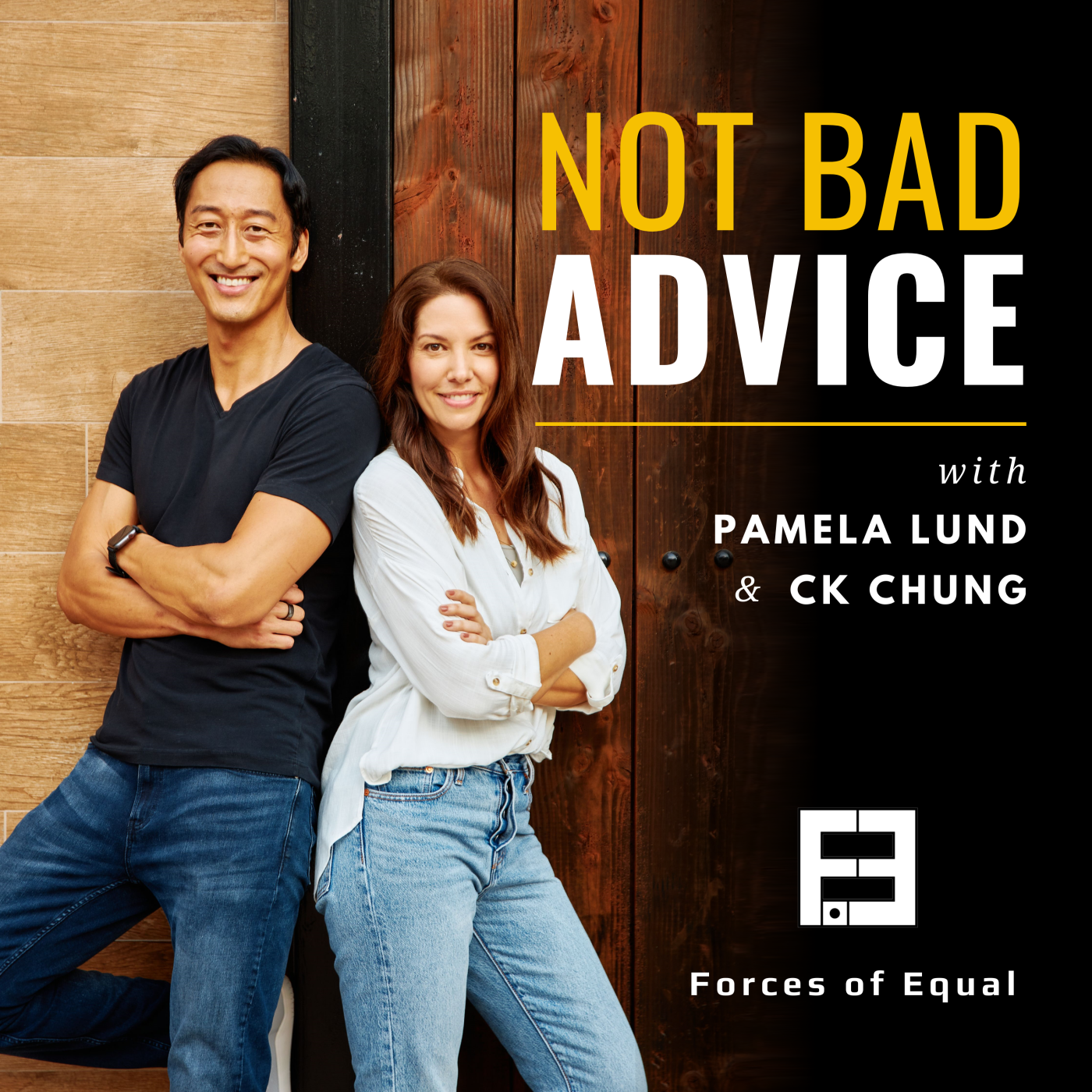Get 3 tips for improving your verbal communication and find out what hostage negotiation can teach us about having better conversations.
Need advice about something? Ask us here: ForcesOfEqual.com/Advice/
Transcript
Pam: [00:06] You’re listening to Not Bad Advice where our goal is to offer a perspective that helps you improve one aspect of your life at a time.
[00:13] I’m Pamela Lund.
CK: [00:20] And I’m CK Chung.
Pam: [00:22] And we hope that after listening you’ll think, “Hey, that’s not bad advice!”
[00:37] I have this theory that the massive amount of scripted and edited entertainment that we consume has affected how we think communication should happen. Instead of interacting with other people in real time, we watch interactions that are full of quick comebacks and clever responses. Even if there is conflict, the fights are perfectly choreographed.
[00:58] I believe that seeing so much artificial conversation sets us up for unrealistic expectations of how real conversations flow, which can make us all feel like we’re awkward weirdos and we’ve become uncomfortable with a break in conversation that lasts even a few seconds.
CK: [01:18] The dreaded awkward silence.
Pam: [01:23] Silence during conversations is so anxiety inducing that many people don’t take time. to Think about what they’re saying, whether they should say anything at all, Or the impact, what they say may have. This fear of silence and the unrealistic expectations of how quickly conversation should flow can cause you to say things you don’t mean, or that you have to walk back later, and can make you commit to doing things that you don’t want to do.
CK: [01:50] It could cause you to lie without meaning to. Or you may just end up sounding more foolish than you would if you took the time to think about what you were about to say.
Pam: [02:01] Yeah. Yeah. Or I’ve been in conversations where there was a lull, and I ended up gossiping just to fill the dead air. And that feels pretty terrible afterwards.
CK: [02:11] Well, as we’re starting to come out of lockdown and get back to having more in-person communication, it seems like a good time to learn how to have better conversations.
Pam: [02:20] All right. Well, the first thing you need to do is the hardest thing. You have to get comfortable with a few seconds of silence, so you can take a beat before answering questions or adding your two cents. It feels super weird at first, but I promise you that it gets easier and that the pause feels longer to you than it does to the person you’re talking to.
[02:43] To get comfortable with long pauses practice with your partner, roommate, or a close friend where the stakes are low. If they ask you a question, take a slow breath before replying. If one breath feels doable, try two. Eventually you want to work your way up to being able to take three fairly slow breaths without crawling out of your skin.
[03:07] If silence feels too awkward at first, you can say, “Hmm…” or “Let’s see…” or something like that, that indicates you’re processing your response. Eventually, you want to stop using this, but it can help you get over the initial discomfort of not speaking right away.
[03:24] Creating this space between the question and your reply gives you time to think about your response. And you need to feel comfortable with the silence, so you can actually use that pause to think. And while your friend or partner may not be asking you difficult questions that need a lot of thought to answer practicing on easy questions will help you build up your confidence so you can take a pause next time you’re put on the spot.
[03:49] The second thing you can do to have better conversations is to stop thinking about your response before the other person has finished speaking. This is almost as hard as getting comfortable with silence, but if you’re already thinking about what you’re going to say, you’ve stopped listening to the other person and you could miss out on valuable information that may change your response.
CK: [04:10] Okay. We need to practice mindfulness in conversation. There’s so many important cues that you can pick up on when you’re focused on the other person, instead of on yourself. Their facial expressions, body language, and the kind of words they use all give you valuable information that you might miss if you’re not paying attention,
Pam: [04:30] Exactly. If you’re used to practicing presence and mindfulness in other areas of your life, it’s the same principle. And doing it in conversation will help you get comfortable with silences because you’ll be forced to take a second to think about what you want to say, since you won’t already have your response ready before they’re even done speaking.
[04:51] The third thing you can do to improve conversations is get comfortable saying “no” and “I don’t know.” Learning how to say “no” confidently is a life changing skill. We just did an episode called “How To Say No,” so go listen to that one, if you missed it.
[05:06] Learning how to say, “I don’t know,” can be just as valuable. It’s okay to not know all the answers. It’s okay to say, “I’ll get back to you” or “Let me find out.” If you give answers on the spot to questions, you don’t actually know the answer to, you may end up lying or misleading the other person, or you could end up accidentally committing yourself to delivering something that isn’t possible.
[05:31] The next tip is the easiest, and it’s one of my favorite tips in general, because it’s so good at improving conversations that it also improves relationships.
[05:41] I started using it a few years ago and it’s definitely helped me and CK avoid some conflicts. So the tip is: when you don’t know how to respond to something or don’t really know what the other person meant to say, or maybe you’re not sure why they’re saying what they’re saying to you, you don’t have to respond.
[06:00] We feel pressure to have all the answers and to have these quick perfect conversational flows, but communication is hard and people are complicated. So rather than answering something with limited information or responding in a way that could make them defensive, just say, “Can you tell me more?”
CK: [06:19] And this is better than just asking “why?” because” responses like that, even when they aren’t meant to be confrontational, can make the other person defensive, but asking, “Can you tell me more?” gives them an invitation to give you more information.
Pam: [06:36] Exactly. The difference may seem insignificant, but it’s not. People hear. “Can you tell me more?” much differently than they hear, “Why?” “Why?” is a challenge. “Tell me more” is an invitation.
[06:51] You also don’t want to respond in a way that isn’t true to how you feel or that isn’t appropriate once you know what the person was really trying to say, just because you rushed into responding. That’s how miscommunication happens and arguments start.
[07:06] Also, I find when I use a, “tell me more” response, people frequently work out their issue on their own. Or they realize they don’t need what they were asking for. Or that what they thought they wanted. Isn’t what they wanted at all. If I hadn’t asked them for more information, we both would’ve acted on bad assumptions, which wouldn’t have been good for anyone.
CK: [07:27] Once you get the hang of this, you can upgrade your communications even further with two simple interview techniques that I noticed are fundamental strategies used by therapists and hostage negotiators. In therapy, they refer to this as making observations and asking questions. And in hostage negotiation, they refer to it as labeling and mirroring.
[07:53] So let’s go with hostage negotiation because that sounds cool.
[07:57] So, labeling and mirroring. Labeling refers to the process of verbally acknowledging the other person’s perspective. And this usually starts with, “it sounds like,” or “it seems like.” And this directly correlates with the therapist strategy of making observations.
Pam: [08:17] So, labeling lets you tell the other person what you’re hearing in a non-confrontational way and reassures them that you’re understanding them.
CK: [08:26] Right. The second strategy, mirroring, is even more simple.
Pam: [08:32] Is mirroring when you copy the movements and behavior of the person you’re talking to?
CK: [08:37] Yeah, that’s a version of it, but this method is even more simple than that. All you basically do is repeat a few key words the other person just said. And to make it even simpler, just repeat the last three words.
Pam: [08:50] The last three words?
CK: [08:51] Yeah, exactly. When you repeat the last three words, you invite the other person to say more without actually asking them to. People will open up and give you way more information when it feels voluntary, instead of like they’re being interrogated.
[09:07] And so mirroring directly correlates with the therapist’s strategy of asking questions. So mirroring and labeling, ask questions and make observations.
Pam: [09:18] Okay. So the three things are, get comfortable with silences, get comfortable saying “no” and “I don’t know,” and ask for more information when you need it, possibly using labeling and mirroring. Doing all those things will dramatically change the outcomes you get from your conversations.
[09:35] The card I chose to represent today’s message is the king of swords. In Tarot, swords are associated with the element of air. Air is related to breath, of course, but also with our thoughts and ideas.
[10:21] Conversation is the exchange of air. It’s the flow of breath and thoughts. It can be a gentle, easy breeze, it can be a gust of wind that nearly knocks you over, or it can be a tornado that destroys everything in its path. The way you use your air affects the outcome you get.
[10:42] Kings in the Tarot represent leadership. If you think of king stereotypes, there’s the kind and tough leader that does what’s best for his kingdom, even if it’s not what feeds his ego. And then there’s the power hungry king that only does what makes him feel big and powerful, which eventually leads to his own downfall.
[11:04] The king of swords asks you to stay solid and present in conversation, even, or especially, when it’s difficult. It asks you to know the difference between true power and bravado. It asks you to use your breath to ground yourself and speak in alignment with what’s best for you and the situation.
[11:26] Practice using your inner king of swords in conversations and see how much your interactions improve when you feel powerful, confident, and present.
[11:39] If you find yourself thinking, “Hey, that’s not bad advice” while listening today, we’d love it if you share the episode with your friends and rated it in iTunes.
[11:47] You can get in touch with us on Twitter, where I’m @Pamela_Lund and CK is @cKdisco.
[11:53] To find us on other platforms, visit ForcesOfEqual.com/Advice. There, you can also contact us if there’s something you need advice about. We’d love to hear from you.






